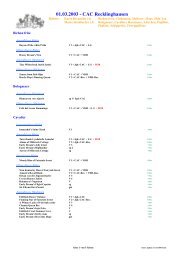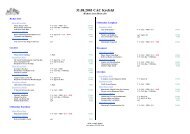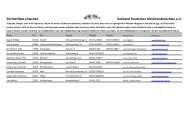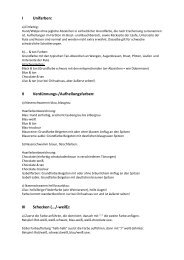FCI-RKF Standard 11.24.2010/Russia Russkaya Tsvetnaya Bolonka ...
FCI-RKF Standard 11.24.2010/Russia Russkaya Tsvetnaya Bolonka ...
FCI-RKF Standard 11.24.2010/Russia Russkaya Tsvetnaya Bolonka ...
You also want an ePaper? Increase the reach of your titles
YUMPU automatically turns print PDFs into web optimized ePapers that Google loves.
<strong>FCI</strong>-<strong>RKF</strong> <strong>Standard</strong> <strong>11.24.2010</strong>/<strong>Russia</strong><br />
<strong>Russkaya</strong> <strong>Tsvetnaya</strong> <strong>Bolonka</strong><br />
The <strong>Russkaya</strong> <strong>Tsvetnaya</strong> <strong>Bolonka</strong> standard was confirmed at the <strong>RKF</strong> committee meeting on<br />
11/24/2010 and became valid with it’s publication in the <strong>RKF</strong> bulletin 5/2010<br />
Translation: Karin Biala-Gauß<br />
©http://cvetbolonka.ru/standart.html
ORIGIN: <strong>Russia</strong><br />
UTILIZATION: Companion<br />
CLASSIFICATION: Group 9, Companion and Toy Dogs<br />
BRIEF HISTORICAL SUMMARY: The creation of the breed started in 1951 in Leningrad.<br />
Following breeds Bolognese, Shih-Zzu, Lhasa-Apso were involved in the creation of the<br />
RUSSKAYA TSVETNAYA BOLONKA. The principal breed’s attributes were small size<br />
(20-24 cm), rich unicolored coat. In 1966 the standard for the “tsvetnaya bolonka” was<br />
confirmed by Ministry of Agriculture. In 1973 the Moscow City Executive Committee<br />
decided to form the “Moscow section of Dog fanciers” (MGOLS) out of the section<br />
“Swerdlowsk interdistrict for companion and Toydogs”. Active breeding work and<br />
cooperation with cynologists of Leningrad approved MGOLS which became the main center<br />
of genetic concerns for the “tsvetnaya bolonka”. In 80’s as popularity of the breed increased<br />
new clubs and breeders emerged. The “National <strong>Tsvetnaya</strong> <strong>Bolonka</strong> Breed Club”was founded<br />
in 1999.<br />
GENERAL APPEARANCE: small, body slightly longer than height, balanced construction.<br />
Elegant appearance due to colours and rich coat. Sweet expression. <strong>Tsvetnaya</strong> bolonka<br />
shouldn’t remind one of Shih-Tzus or Poodles.<br />
IMPORTANT PROPORTIONS: Body length does not exceed height at withers by more than<br />
15%. The depth of the chest should be 50% of the height at withers. The length of a muzzle is<br />
little more than one third of head length.<br />
BEHAVIOUR/TEMPERAMENT: Affectionate dog with lively temperament and wellbalanced<br />
character.<br />
HEAD: In harmony with the rest of the body.<br />
CRANIAL REGION: Skull is rounded, slightly domed. Occiput little defined. Stop well<br />
defined.<br />
FACIAL REGION:<br />
Nose: small, vertical in profile, nostrils are well opened; nose black or corresponding to<br />
colour, preferably dark.<br />
Muzzle: rather short, dry, slightly tapering to nose. Foreface straight, wide at the base. Lower<br />
jaw is rather wide.<br />
Lips: tight, black or corresponding to colour, preferably dark.<br />
Jaws/teeth: scissor bite preferred. Level bite and slight undershot are tolerated. Teeth are<br />
white, strong. Incisors set square to the jaw, complete set of incisivi and canines desired.<br />
Cheeks: Cheeks are slightly rounded.
Eyes: Medium size, dark, round, eyes in socket. Chocolate coloured dogs may have lighter<br />
coloured eyes; eyelids tight to the eyes, Black or corresponding to colour. Lively and friendly<br />
expression.<br />
Ears: Moderate size, V-shaped with slightly rounded tips. Set on moderate height, pendent.<br />
Garnished with beautiful hair.<br />
Neck: moderate length, proud carriage, lean and well muscled.<br />
BODY: compact and moderately wide<br />
Top line: level.<br />
Withers: moderately defined.<br />
Back: Straight, strong, broad, well muscled, moderately long.<br />
Loin: Slightly arched.<br />
Croup: Rounded, medium length, rather broad, slightly sloping, muscled.<br />
Chest: Moderately broad, oval shaped, long, brisket should reach to the elbows.<br />
Lower line: Belly moderately tucked up.<br />
TAIL: medium length, high set, arched over topline, tip touches body. Tail must be<br />
completely covered by coat.<br />
LIMBS<br />
FOREQUARTERS:<br />
Straight and parallel, when viewed from the front, moderately apart from each other.<br />
Shoulders: Well sloped, well muscled, angulation 100-110°<br />
Elbows: Straight, pointing neither in nor out.<br />
Lower arms: In prolongation with upper arm.<br />
Pasterns: Strong, almost vertical.<br />
Forefeet: Small, round, arched, well closed. Dark pads and nails.<br />
HINDQUARTERS:<br />
Straight and parallel, moderately apart from each other.
Thigh: Of medium length, well muscled, oblique.<br />
Stifle: Round, angles moderately defined.<br />
Tibia: of moderate length, not too straight<br />
Hocks: Lean, strong, moderately angulated and long, .<br />
Rear pasterns: of medium length, upright.<br />
Hind feet: little smaller than forefeet, of oval shape, well closed. Dark pads and nails<br />
GAIT: easy, free<br />
SKIN: elastic, without wrinkles, pigmentation corresponds to coat colour.<br />
COAT: Long, silky, shining, thick, with developed undercoat, covers the whole body in even<br />
length. Hair dense and heavy, showing big curls or waves. Big curls are preferable, waves<br />
tolerated.<br />
COLOR: Any color allowed except white and parti. Small white markings on chest and toes<br />
are tolerated.<br />
SIZE AND WEIGHT: Height at the withers: preferable size (Height at the withers – males<br />
and females): up to 26 cms.<br />
Weight: males and females: 3-4 kgs.<br />
Faults:<br />
1. body too square or too long, too high or too short on legs<br />
2. flat forehead, diminishing stop, long muzzle<br />
3. missing incisor<br />
4. straight coat<br />
5. thin coat<br />
Severe faults:<br />
1. erect or half erect ears<br />
2. bulging eyes<br />
3. missing 2 or more incisors<br />
4. overshot bite<br />
5. missing undercoat<br />
6. kinked tail<br />
7. short bowed forearms<br />
8. large white markings on the chest, white paws<br />
Disqualifying faults:
1. non standard colour<br />
2. missing beard or furnishings<br />
3. undershot bite, cross bite<br />
4. height at withers more than 28cm<br />
5. aggression, weak temperament<br />
6. blue eyes , odd eyed<br />
7. missing tail, short tail<br />
8. evident dwarfism<br />
N.B. : Male animals should have two apparently normal testicles fully descended into the scrotum.













